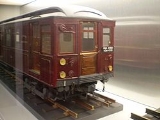
London Underground E Stock
Encyclopedia
The London Underground E Stock were steel-bodied cars built for the London Underground in 1914 by the Gloucester Railway Carriage and Wagon Company
.
Thirty cars were built, twenty-six driving motor cars and four trailers. The E stock was based on the earlier C Stock
and D Stock
but differed in that the roof was elliptical rather than the clerestory
roof of the C Stock
and D Stock
.
In the 1940s the C, D and E stocks were reclassified as "H Stock" (signifying hand-operated doors), along with other pre-1938 District Line rolling stock that had not been converted to have air-operated doors. The H Stock was largely eliminated by the early 1950s, following replacement by R Stock
. The remaining cars were largely confined to the Olympia shuttle service. The last example was withdrawn in 1958; no E Stock car has been preserved.
They were generally similar in appearance to the B Stock
, except that the E Stock had an elliptical roof.
Gloucester Railway Carriage and Wagon Company
Gloucester Railway Carriage and Wagon Company was a railway rolling stock manufacturer based at Gloucester, England; from 1860 until 1986....
.
Thirty cars were built, twenty-six driving motor cars and four trailers. The E stock was based on the earlier C Stock
London Underground C Stock
The C Stock was built for the Metropolitan District Railway in 1910. The additional rolling stock was required to increase the frequency of the service , plus the four-tracking of the section west of Hammersmith which allowed a greater frequency of trains to and from...
and D Stock
London Underground D Stock
The D Stock was built by Metropolitan Amalgamated Railway Carriage & Wagon in Saltley, England for the Metropolitan District Railway in 1912. A total of thirty cars were built, twenty-two were driving motor cars and eight were trailers. In 1928 the eight trailer cars were rebuilt into motor cars at...
but differed in that the roof was elliptical rather than the clerestory
Clerestory
Clerestory is an architectural term that historically denoted an upper level of a Roman basilica or of the nave of a Romanesque or Gothic church, the walls of which rise above the rooflines of the lower aisles and are pierced with windows. In modern usage, clerestory refers to any high windows...
roof of the C Stock
London Underground C Stock
The C Stock was built for the Metropolitan District Railway in 1910. The additional rolling stock was required to increase the frequency of the service , plus the four-tracking of the section west of Hammersmith which allowed a greater frequency of trains to and from...
and D Stock
London Underground D Stock
The D Stock was built by Metropolitan Amalgamated Railway Carriage & Wagon in Saltley, England for the Metropolitan District Railway in 1912. A total of thirty cars were built, twenty-two were driving motor cars and eight were trailers. In 1928 the eight trailer cars were rebuilt into motor cars at...
.
In the 1940s the C, D and E stocks were reclassified as "H Stock" (signifying hand-operated doors), along with other pre-1938 District Line rolling stock that had not been converted to have air-operated doors. The H Stock was largely eliminated by the early 1950s, following replacement by R Stock
London Underground R Stock
The R38, R47, R49, and R59 Stock cars were built for the District Line in 1938, 1949, 1952 and 1959. R Stock cars were driving motors and non-driving motors...
. The remaining cars were largely confined to the Olympia shuttle service. The last example was withdrawn in 1958; no E Stock car has been preserved.
They were generally similar in appearance to the B Stock
London Underground B Stock
The London Underground B Stock was built in 1905 for the Metropolitan District Railway . 420 vehicles were built, formed into sixty 7-car units....
, except that the E Stock had an elliptical roof.

